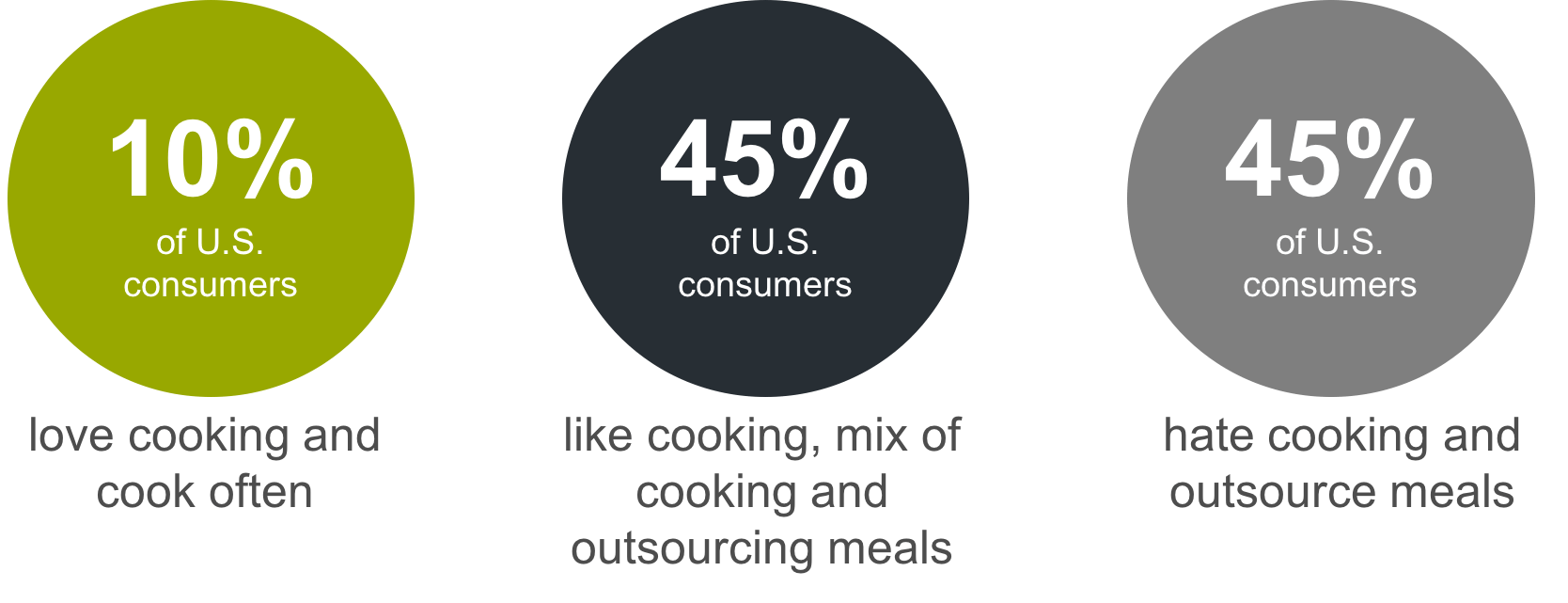Don’t Just Cook. Cook Different.
In his September 2017 Harvard Business Review article, author Eddie Yoon grabbed the food industry’s attention with the headline “The Grocery Industry Confronts a New Problem: Only 10% of Americans Love Cooking.” In the opening paragraph, he asserts:
“Although many people don’t realize it yet, grocery shopping and cooking are in a long-term decline. They are shifting from a mass category, based on a daily activity to a niche activity, that a few people do only some of the time.”
Yoon contends there are three categories of consumers when it comes to cooking based on his research:

In an already challenging environment for grocery retailers and CPG companies, this new research felt like another kick in the gut.
Good thing Yoon got it (mostly) wrong.
WHY IT’S HAPPENING
In many ways, scratch cooking has transitioned from necessity to luxury. With competing demands for time and resources, a seemingly endless host of options–takeout, delivery, meal kits and retail prepared foods–allow consumers to forgo cooking on a regular basis.
But all this evidence ignores a key consumer need: the emotional connection we have when preparing and sharing a meal with loved ones. Consumer insights firm Iconoculture asserts that cooking hits on key consumer values important to all generations–particularly millennials: creativity, sharing, discovery and tradition.
What we’re seeing is not a dramatic decline in the desire to cook; but rather, the misalignment in the value of cooking versus the act of cooking.
WHAT WE THINK
As food and beverage manufacturers, we must embrace and celebrate how modern consumers really cook.
Apple was successful in revolutionizing the mobile tech world because they focused first on the customer’s need to communicate better, not the phone itself. What Yoon’s research illuminates is a truly unique business opportunity for food manufacturers and retailers–if we’re willing to think differently. We should focus on the basic human desire to prepare and share a meal, letting go of rigid definitions of what cooking is and isn’t. Retail products, prepared foods, meal kits and foodservice aren’t competing channels; but rather, cooking tools that can be wielded in any combination to help modern consumers put a meal on the table.
WHAT’S NEXT
Traditional cooking will never completely go away; there are celebrations and occasions where scratch-cooking is expected and sought after. But for the other 360 days of the year, we can help consumers leverage both retail and foodservice solutions to prepare an easy meal without sacrificing freshness, quality or that coveted emotional connection.
Encourage Fake-It-From-Scratch
Iconoculture’s recent consumer research shows that even the youngest consumers know cooking is an important life skill. Encourage customers with even basic kitchen abilities and limited time to be a fake-it-from-scratch cook. Demonstrate how one or two prepared items and a few simple ingredients can create a delicious weeknight meal, like this 10-Minute-Taco-Tuesday recipe:

Promote Cooking-Less Celebrations
One of the key instances where consumers want to cook is when they’re entertaining family and friends. And sharing food with people we love is what it’s all about. But hosting a dinner party is a daunting task. I’m a huge fan of Kitchn’s 5 Rules For Hosting a Crappy Dinner Party (And Seeing Your Friends More Often), especially Rule #2:
The 5 Rules of a Crappy Dinner Party:
Ready to plan your own? Here’s how to do it:
- No housework is to be done prior to guest’s arrival
- The menu must be simple and doesn’t involve a special grocery trip
- You must wear whatever you happen to have on
- No hostess gifts allowed
- You must act like you’re surprised when your friends or family just happen to show up at your door (optional)
This is an ideal opportunity to demonstrate how to use foodservice–especially delivery–along with ingredients already in the kitchen to craft a crowd-pleasing menu.
And rather than focusing on traditional gatherings like housewarming or birthday parties, brands should encourage consumers to celebrate unconventional milestones like adopting a pet, paying off student loans or seasoning a newly purchased grill.
